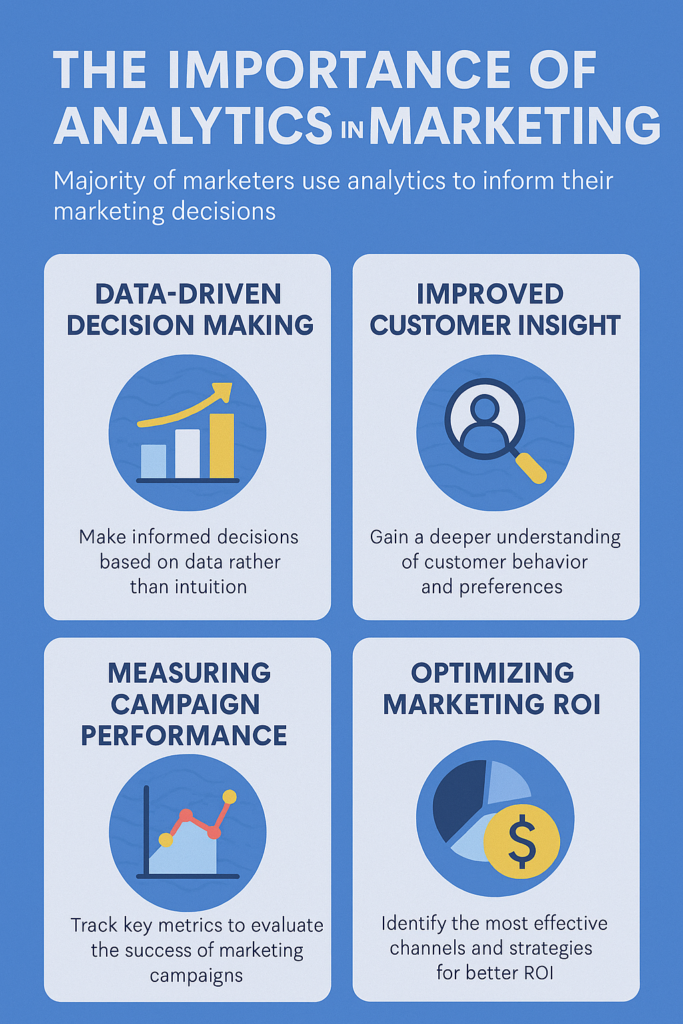
In the digital age, data is the new currency—and marketing analytics is the foundation of modern marketing success. Whether you’re running paid ads, posting on social media, or optimizing your website, analytics helps you understand what works and what doesn’t.
Gone are the days when marketers relied solely on gut instinct. Today, marketing without analytics is like driving blindfolded. You need data to make decisions, track performance, understand your customers, and optimize results.
In this article, we’ll dive deep into the importance of analytics in marketing, including its key benefits, how it works, and how to apply it to grow your brand effectively.
1. What is Marketing Analytics?
Marketing analytics is the process of measuring, managing, and analyzing marketing performance to maximize its effectiveness and optimize return on investment (ROI). It involves collecting data from all marketing channels and consolidating it to:
- Track performance
- Understand consumer behavior
- Predict future trends
- Improve campaigns
It gives marketers a 360-degree view of how users interact with their brand across platforms like social media, email, websites, ads, and more.
2. Why Marketing Analytics is Important
a) Data-Driven Decision Making
Analytics removes guesswork. Instead of asking, “What should we post today?” or “Why aren’t we getting leads?”, marketers use hard data to:
- Decide what content to publish
- Allocate budgets to the best-performing channels
- Create strategies based on proven results
💡 Example: Google Analytics can show that blog posts with video content get 60% more time-on-page. That insight can drive your future content strategy.
b) Improved Customer Understanding
Analytics helps you understand:
- Who your customers are
- What they like
- Where they come from
- What type of content they engage with
This allows for personalized marketing, which increases conversions and customer satisfaction.
💡 Example: Facebook Audience Insights can tell you the age, gender, and interests of your followers—useful for creating targeted content or ads.
c) Campaign Performance Measurement
Every campaign should have measurable goals. Whether it’s website visits, form submissions, or app installs—analytics tells you how each campaign performed.
Key metrics include:
- Click-through rate (CTR)
- Conversion rate
- Cost per acquisition (CPA)
- Engagement rate
You can see what’s working and what needs improvement in real-time.
d) ROI Optimization
By identifying which channels, campaigns, or audience segments drive the highest ROI, businesses can double down on what’s profitable and cut what’s not.
💡 Example: If email marketing is generating 70% of your sales while Google Ads is underperforming, you can shift budget and focus.
e) Predictive and Prescriptive Insights
Modern analytics platforms don’t just tell you what happened—they predict what’s likely to happen next. AI tools can:
- Forecast future sales
- Suggest best times to post content
- Recommend budget allocations
This forward-thinking approach keeps you ahead of competitors.
3. Types of Marketing Analytics
Understanding the different types of analytics can help you better structure your strategy.
a) Descriptive Analytics
Explains what happened (e.g., how many people visited your site last week).
b) Diagnostic Analytics
Explains why something happened (e.g., bounce rates increased due to slow website speed).
c) Predictive Analytics
Forecasts future behavior (e.g., predicting holiday season sales spikes).
d) Prescriptive Analytics
Suggests actions to take (e.g., use more video content in paid ads).
4. Tools for Marketing Analytics
Here are some of the best tools marketers use:
| Tool | Purpose |
|---|---|
| Google Analytics | Website traffic and user behavior |
| Meta Ads Manager | Facebook & Instagram ad performance |
| SEMrush / Ahrefs | SEO, backlinks, keywords |
| HubSpot | CRM, email marketing, campaign tracking |
| Hootsuite / Buffer | Social media analytics |
| Hotjar | Heatmaps and user interaction |
| Google Looker Studio | Custom dashboards and reporting |
Choose tools based on your marketing channels and goals.
5. How to Use Analytics in Your Marketing Strategy
Step 1: Set SMART Goals
- Specific, Measurable, Achievable, Relevant, Time-bound
- Example: “Increase Instagram engagement by 25% in 3 months”
Step 2: Choose the Right KPIs
Track only what matters for your goal. Don’t fall into vanity metrics.
Step 3: Monitor and Adjust
Check analytics weekly or monthly. Make tweaks to your content, ads, or offers based on results.
Step 4: A/B Testing
Test different versions of ads, landing pages, or email subject lines to see what performs better.
6. Real-World Example: How Analytics Saved a Campaign
Imagine a brand running Facebook Ads with no leads in 2 weeks. With analytics, they discovered:
- 80% of clicks came from mobile
- The landing page wasn’t mobile-friendly
After fixing the page, conversions increased by 40%. That’s the power of analytics.
7. Challenges in Using Analytics (And Solutions)
| Challenge | Solution |
|---|---|
| Too much data | Focus on 3–5 main KPIs |
| Inconsistent tracking | Use tracking tools and set up UTM links |
| Lack of expertise | Hire or consult with analytics experts |
| Delay in insights | Use real-time dashboards (like Google Looker Studio) |
8. The Future of Analytics in Marketing
With AI and machine learning, analytics will only get smarter. Expect:
- Hyper-personalized content recommendations
- Automated campaign optimization
- Real-time customer journey tracking
Brands that invest in data today will be the winners of tomorrow.
Conclusion
Marketing analytics is no longer optional—it’s essential.
It helps marketers: ✅ Make better decisions
✅ Understand their audience deeply
✅ Measure results and ROI
✅ Optimize campaigns for long-term success
By using analytics wisely, you don’t just save money—you also scale faster and build stronger relationships with your customers.
So, if you’re not leveraging analytics yet, now is the time to start.
And if you need help setting up or analyzing your marketing data, connect with our expert team at WebMarkitors. Let’s make every click count!

